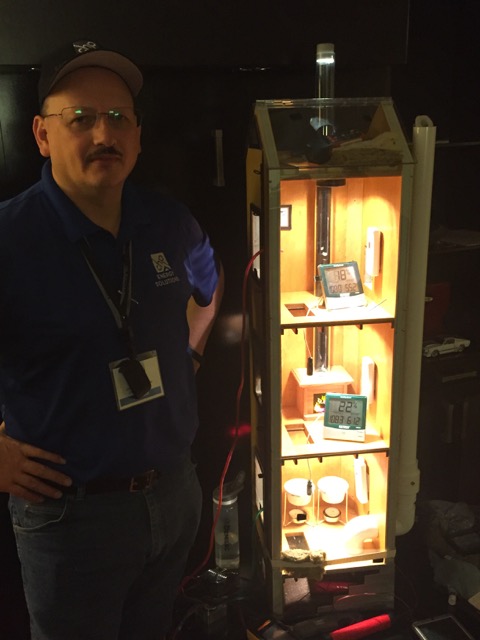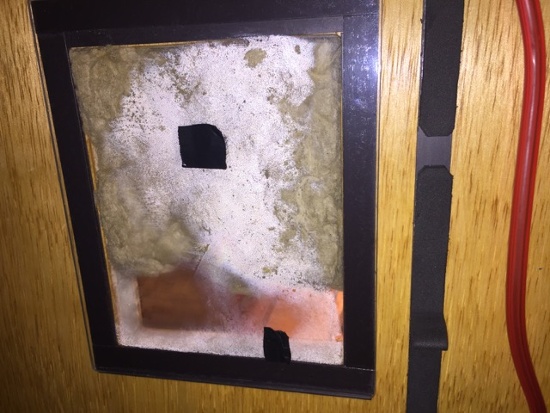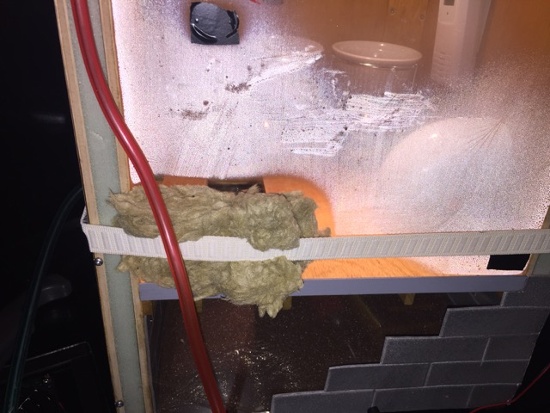A Vivid Demonstration of the Benefit of Exterior Insulation

A couple of weeks ago I caught up with Anthony Cox at the Air Barrier Association conference in Baltimore. You may know Anthony as the inventor of the House of Pressure, a great model for demonstrating backdrafting, zonal pressure differences, and other building pressure phenomena. Well, now he’s got a new toy and he brought it to Baltimore for the conference.
It’s a taller model that he can use to demonstrate stack effect, but what I found most interesting was his vivid demonstration of the difference between interior and exterior insulation. Most people who go to conference hospitality suites do so to drink and socialize…uhhhhhh…I mean, to network. Anthony goes there to show people his new toy.
I’ll make this quick because I’m writing on a plane to Austin for the ACI National Conference right now. If you’re going to be there, maybe you’ll get a chance to see this in person.
Here’s what he did. He closed up the demo house, put a couple of pots of water to boil down in the basement, and then watched as condensation started forming. In the first photo below, you can see condensation on the plexiglass wall, behind the interior insulation.

In the second photo, you can see condensation on the interior side of the plexiglass on all the uninsulated area. But there’s no condensation on the wall behind the exterior insulation. Wow!

Last year I wrote about the Building Science Corporation study of double-stud walls with a foot of insulation. What they found when they opened the walls after three years was that condensation had formed on the inside of the exterior sheathing. That’s the case in the middle photo above.
When you put insulation on the exterior of a building, you get two big benefits: Continuous insulation and warmer sheathing. The latter is what Anthony demonstrated in Baltimore, and it’s a significant benefit. Keep the sheathing above the dew point and you don’t collect moisture there. Moisture accumulating in exterior sheathing can create durability problems as well as indoor air quality problems if it starts growing mold.
Dr. Joe Lstiburek put it best: If you want to stay warm, you wear your sweater on the outside. You don’t eat it. Likewise with buildings.
Related Articles
Dew Point — A More Meaningful Measure of Humidity?
Is This the End of the Double-Wall, Cold Sheathing Scare?
Moisture and the Quirkiness of OSB
NOTE: Comments are moderated. Your comment will not appear below until approved.
This Post Has 14 Comments
Comments are closed.

Would this demonstration not
Would this demonstration not also support the need for a good vapor barrier on the INSIDE of the studs? Or even better yet, closed cell spray foam that does not allow moisture to reach the the outside wall surface.
Thomas, it might appear that
Thomas, it might appear that another way to prevent moisture accumulation on the exterior sheathing would be to put in a sheet of polyethylene or some other Class 1 vapor retarder. That way almost no water vapor from inside the house could find the sheathing.
That works fine in a heating-only climate. As soon as you put air conditioning in the building, though, that vapor barrier is in the wrong place. See my article on putting plastic in a wall:
What Happens When You Put a Plastic Vapor Barrier in Your Wall?
http://www.energyvanguard.com/blog-building-science-HERS-BPI/bid/75130/What-Happens-When-You-Put-a-Plastic-Vapor-Barrier-in-Your-Wall
Closed cell spray foam is a Class 2 vapor retarder and isn’t the same as putting poly under the drywall. It can work fine.
Hi Allison,
Hi Allison,
I have a 1922 stucco home in Maine with uninsulated basement walls. Are you saying that it is better for me to leave the basement walls uninsulated, rather than insulate them from the inside? Because it is not feasible to insulate the field stone foundation from the outside.
Ann, without greeting into a
Ann, without greeting into a lot of questioning about your particular situation you might just want to check Dr. Joe’s comments and experience with his own basement.
http://buildingscience.com/documents/insights/bsi-041-rubble-foundations
And now there have been
And now there have been several reports on Green Building Advisor that exterior insulation (of, seemingly, every type) attracts and fosters termites, carpenter ants, birds and rodents. http://www.greenbuildingadvisor.com/blogs/dept/qa-spotlight/if-ants-rigid-foam-should-we-stop-using-it?utm_source=eletter&utm_medium=eletter&utm_content=gba_eletter&utm_campaign=green-building-advisor-eletter
David Eakin, I read the GBA
David Eakin, I read the GBA thread about exterior rigid foam. From that thread, and following the topic of exterior insulation for several years, I understand that people have concerns in some environments about ants in rigid foam. But I have not heard of concerns with the denser rigid mineral wool “boards” that are used for exterior insulation. I’d be very comfortable specifying mineral wool.
Allison: great demo, thanks for sharing it. Some pictures are worth a million words.
Just wanted to follow the
Just wanted to follow the discussion…
Hi,
Hi,
I thoroughly enjoy reading your blog and often use it as an inspiration when I write my blog. Thank you!
I would love to share with you the configuration of our “Exterior Wall” for your critique.
@David Eakin-the naysayers
@David Eakin-the naysayers have been around for years, and probably always will be. It doesn’t matter the subjext, someone is always there to cast stones.
While certainly not very long term or definitive, I have been building full ICF homes for over 12 years, and have not seen or heard of any of these troubles from any of our clients. This is with the foam going below grade-extending from footing to truss! I have to imagine that the risk is lower if the foam is used only on the above grade walls. Of course, it is necessary that one does not leave the foam unprotected.
Jake (and Andrew) – I hope
Jake (and Andrew) – I hope that you also respond to the GBA blog as it seemed few chimed in to counter the claims of ubiquitous damage. I had thought that exterior insulation (particularly when doing a deep-energy retrofit on a masonry structure) would be extremely beneficial, but the reports of invasive nature are very concerning.
As far as termites go —
As far as termites go — whether or not the risk is overstated or not may be irrelevant if you can’t get a pest warranty or termite report, as required by all mortgage companies. When I built my previous home in Charlotte, I consulted with two very knowledgeable pest control companies and adapted my design based on what I learned.
What did you learn?
What did you learn?
Pest control companies, like a national one, say they won’t give a termite warranty if the crawlspace gets sealed, and then 2 years later that same pest company is sealing crawlspaces.
To prevent mistakes we need
To prevent mistakes we need to be definate for every single location the the amount, kind and location of insulation required. The building inspecors need to be trained to be on site to check when the insultation is installed. These mistakes should NEVER BE MADE now that we have all this knowledge. Do we want these buildings to be durable?
We started doing exterior
We started doing exterior foam board insulation in 1999 when a couple of area builders said it could not be done. We are still doing this normally with at least 1 inch and sometimes 1.5 inches and caulking the seams and taping the seams as well. We start about 2 inches below the rim joist area if possible and go all the way to the top whether that is the gable peak or the sidewall. Doing this has provided us with us with very low energy usage for our rental property portfolio. Ironically, the very same contractor who said it could not be done has just built his first duplex in about 20 years using the same process. Amazing.